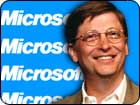|
A mixed message from Microsoft
|
 |
January 17, 2002: 7:22 p.m. ET
Software maker logs higher revenue, sees weakness in coming months.
|
NEW YORK (CNN/Money) - Strong sales of its latest operating system software and its new gaming console helped boost Microsoft's fiscal second-quarter revenue, but legal expenses and a delay in the sale of some assets weighed on its bottom line.
After the close of trading Thursday, Microsoft reported a net profit of $2.28 billion, or 41 cents per share, compared with $2.62 billion, or 47 cents per share, a year earlier.
Excluding a $660 million charge related to legal expenses stemming from consumer class-action suits, Microsoft's operating earnings were $2.84 billion, or 49 cents per share.
Analysts generally had expected Microsoft (MSFT: down $3.01 to $66.85, Research, Estimates) to report a profit of 43 cents per share, according to a survey conducted by earnings tracker First Call.
However, the accuracy of that forecast remained in question late Thursday, as it was unclear whether all of them had adjusted their estimates to account for the legal charges as well as a delay in the sale of Microsoft's stake in online travel company Expedia (EXPE: down $0.40 to $43.55, Research, Estimates).
The company's second-quarter revenue rose 17 percent to $7.74 billion from $6.59 billion a year earlier.
By First Call's count, analysts generally were expecting Microsoft's second-quarter revenue to come in nearer $7.27 billion.
Executives of Microsoft attributed the stronger revenue in part to brisk sales of new products, including its Xbox video-game console and its Windows XP operating system.
They also said cost-cutting was responsible in part for the higher results.
And while they raised the bar for growth in the current quarter, executives lowered expectations for the fiscal year ending in June.
"We see an admittedly mixed environment," Microsoft Chief Financial Officer John Connors said in a teleconference Thursday evening.
For the current quarter ending in March, Connors said Microsoft's profit is likely to range between 50 cents and 51 cents per share on revenue between $7.3 billion and $7.4 billion. Analysts recently had forecast a profit of 47 cents per share on sales of $7.5 billion.
At the same time, he said earnings for the fiscal year ending in June will range between $1.57 and $1.60 per share on sales between $28.8 billion and $29.1 billion. Analysts recently had expected the company's profit for the year to be nearer $1.83 per share on sales of about $28.6 billion.
Microsoft is the world's largest supplier of computer software and the dominant supplier of the operating systems that make them work. Some version of its Windows operating system is installed on the vast majority of the world's PCs, and its business is largely dependent on the health of the PC industry.
And in Microsoft's view, after capping off one of its worst years ever, the industry is still ailing.
"The global PC market continued to deteriorate in the December quarter, with all major economies around the world reflecting the weakness," Connors said.
"Although the month of December was somewhat better than we had expected, we do not think we are in a recovery leading to positive growth in the future," Connors added.
Connors said Microsoft's current forecast is for continued weakness in the PC industry over the next two quarter, with the a decline of 5-to-9 percent.
During the fiscal second quarter, Microsoft's sales of desktop platforms -- referring to its Windows operating system software -- rose 24 percent to $2.5 billion. Executives attributed the strong performance their to a better-than-expected holiday season, which gave a lift to Windows XP, the company's newest consumer operating system.
The company said it has sold more than 17 million copies of Windows XP sold 17 million copies either pre-installed on new PCs or at retail stores, since it launched last October.
But for the full fiscal year, Connors said the company is expecting more modest growth in the platforms business, somewhere in the "low double digits."
Second-quarter sales of desktop applications, including the Office suite of productivity programs, fell 1.4 percent to $2.45 billion. For the full year, Connors said the company is anticipating percentage growth for that unit to be in the "lower to mid-single digits."
Meanwhile, second-quarter sales of enterprise software, which includes programs that power network servers and e-mail programs, rose 4 percent to $1.3 billion. That was less than the company had told analysts they expected at the outset of the quarter, and Connors blamed weaker-than-expected economic conditions for the shortfall.
Click here to check software stocks
Looking ahead, Connors said Microsoft is anticipating percentage growth in enterprise software sales for the full fiscal year to be in the "low double-digits."
The brightest spot on Microsoft's income statement for the second quarter was its newest area of focus: consumer software, services and devices. Revenue from that unit more than doubled to $1.2 billion from $506 million a year earlier.
Much of that gain can be attributed to sales of the Xbox game console and the related game titles. The company claims it sold 1.5 million of the Xbox consoles, which retail for $299, and reported robust sales of Microsoft titles such as "Halo" and "Project Gotham Racing."
Xbox is Microsoft's first foray into the computer gaming industry, currently dominated by Sony and Nintendo, and the company is selling the consoles at a loss, hoping ultimately to profit from the sale of the game titles.
Microsoft executives have described the Xbox as a first step in the company's long-term vision for home entertainment. Connors said Microsoft expects to have shipped between 4.6 million and 6 million Xbox consoles by the end of June.
Connors said Microsoft MSN Internet service also contributed to the upside revenue surprise in its consumer division during the second quarter, and the company anticipates strength in that business to continue through the second half of its fiscal year. 
|
|
|
|
|
|

|

